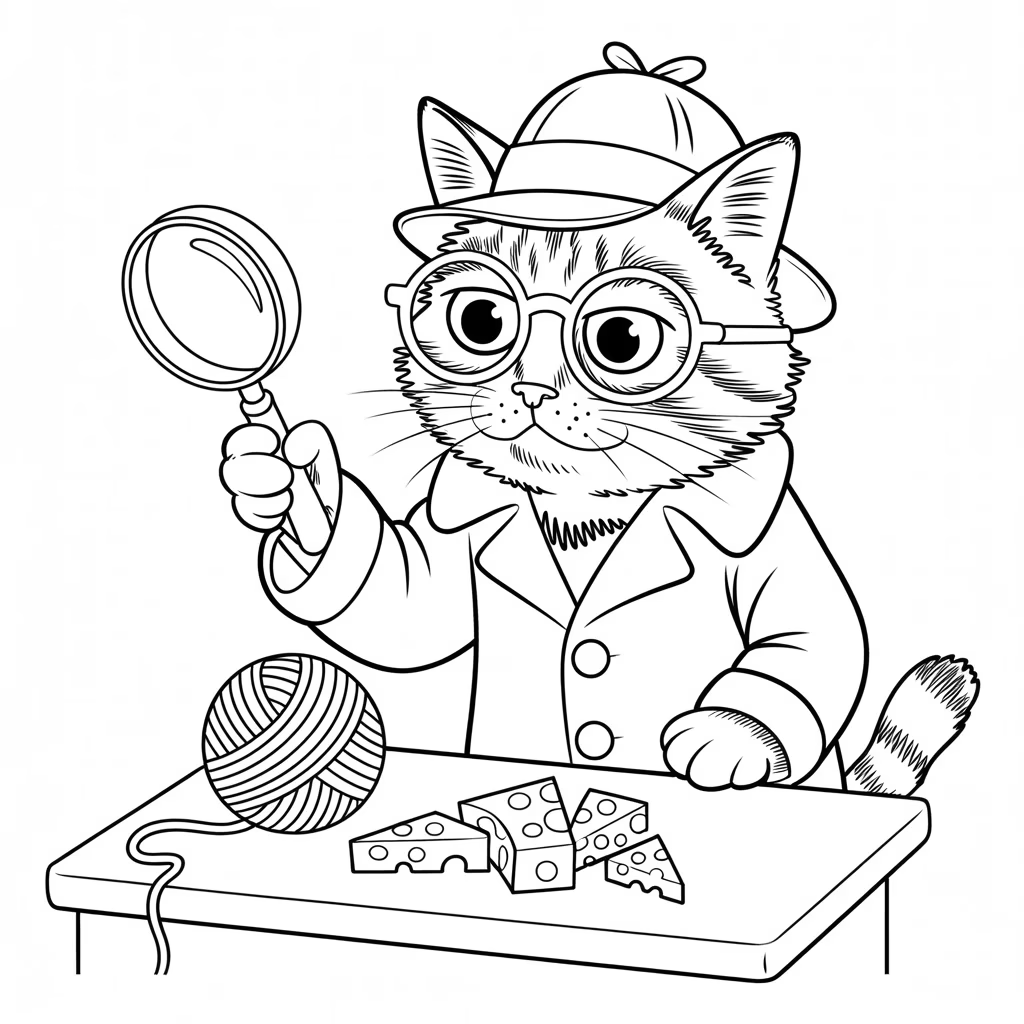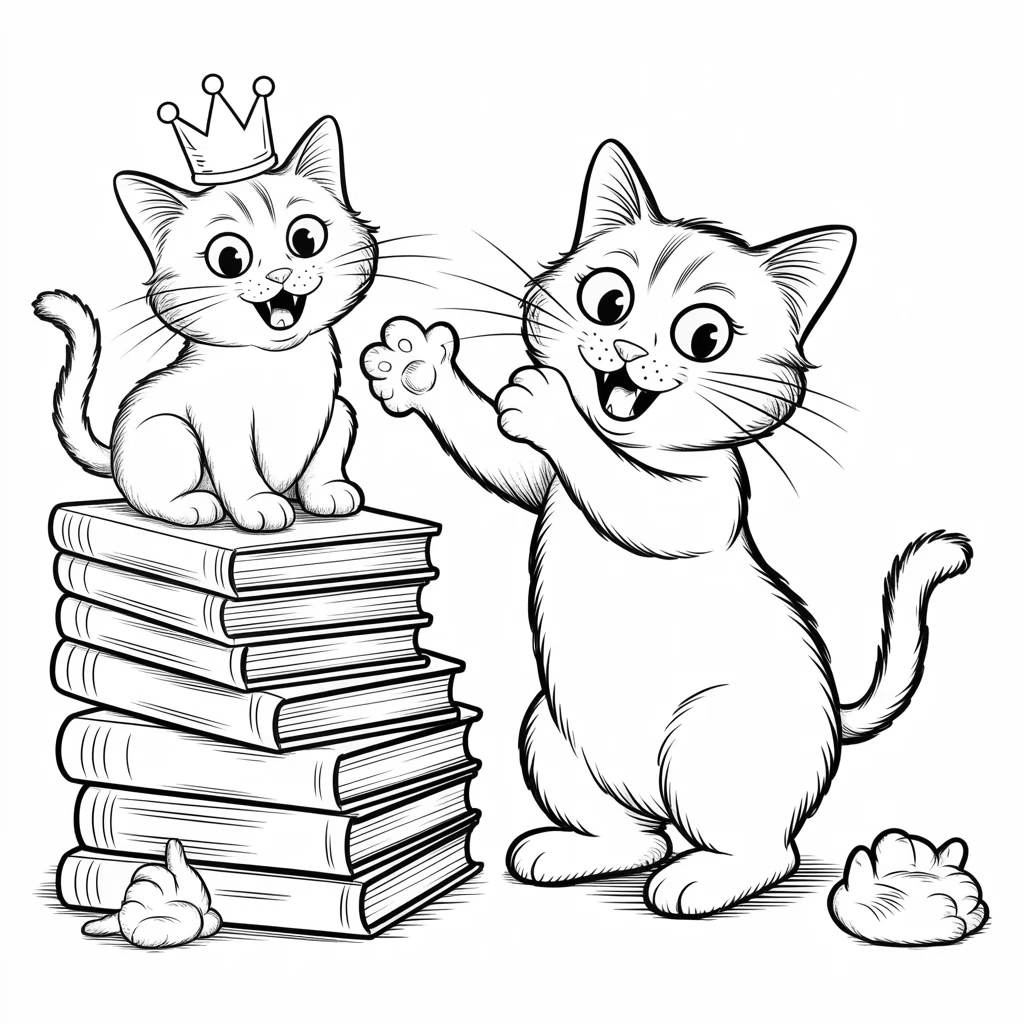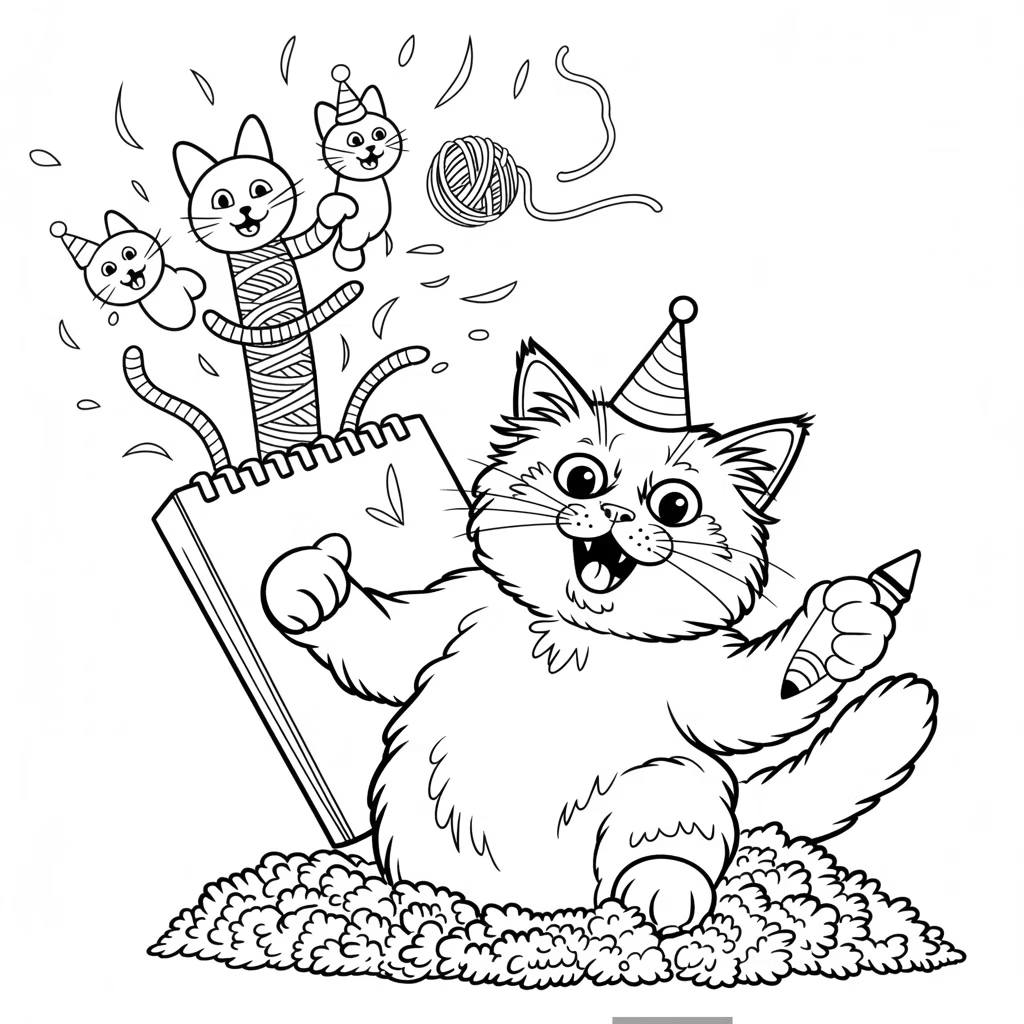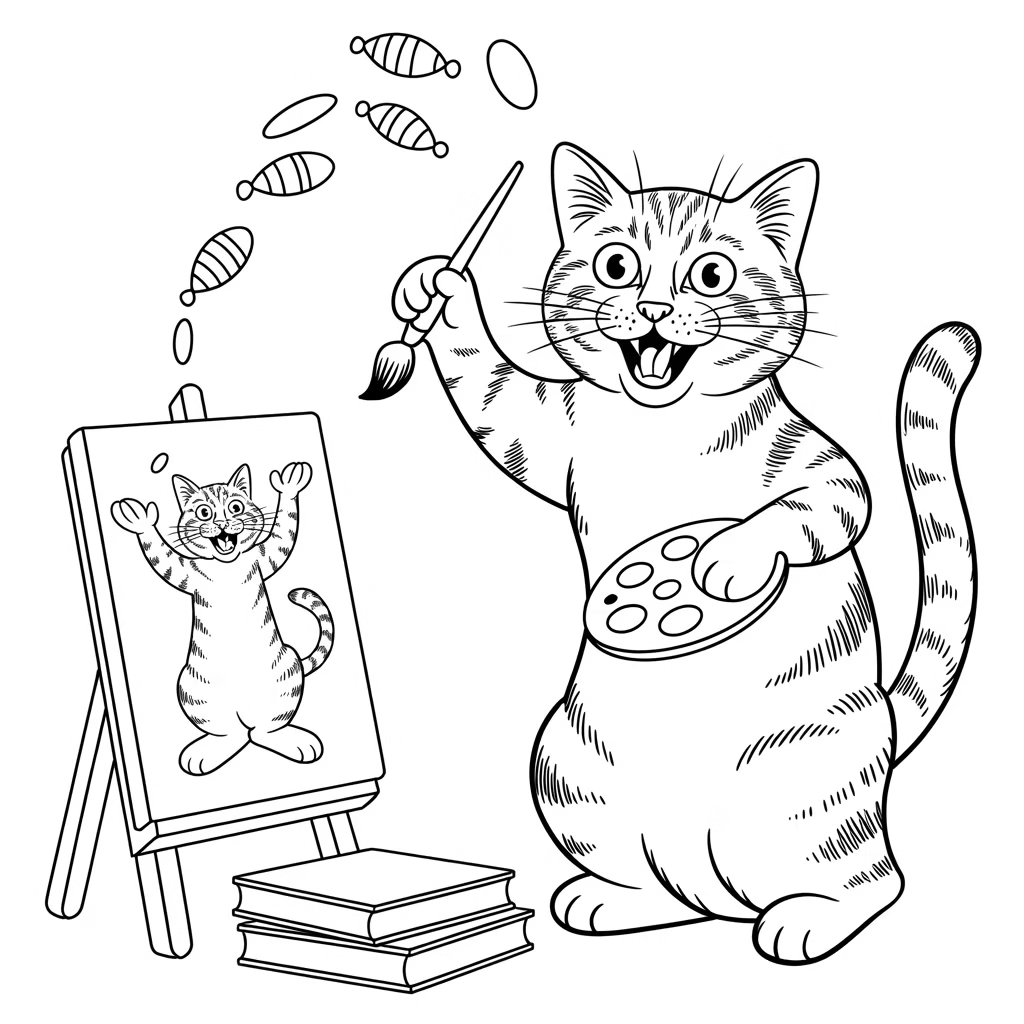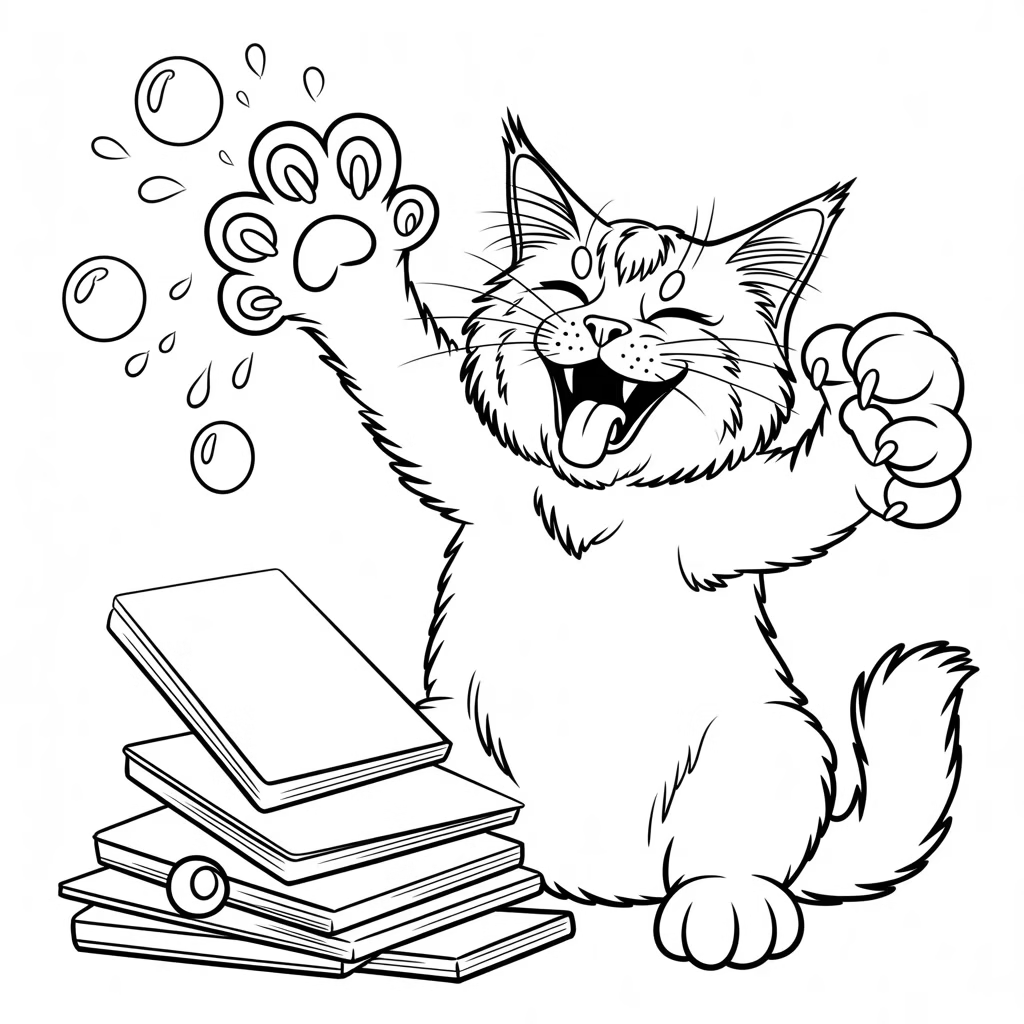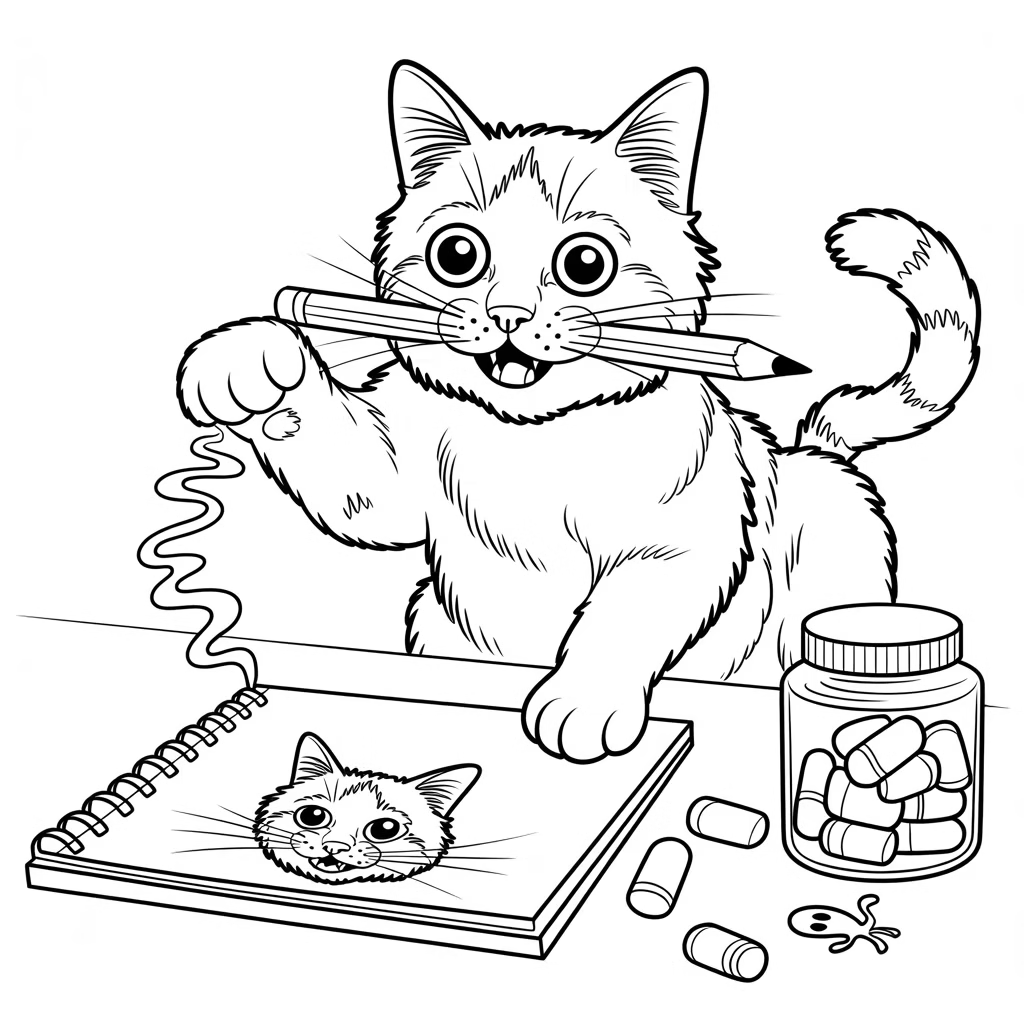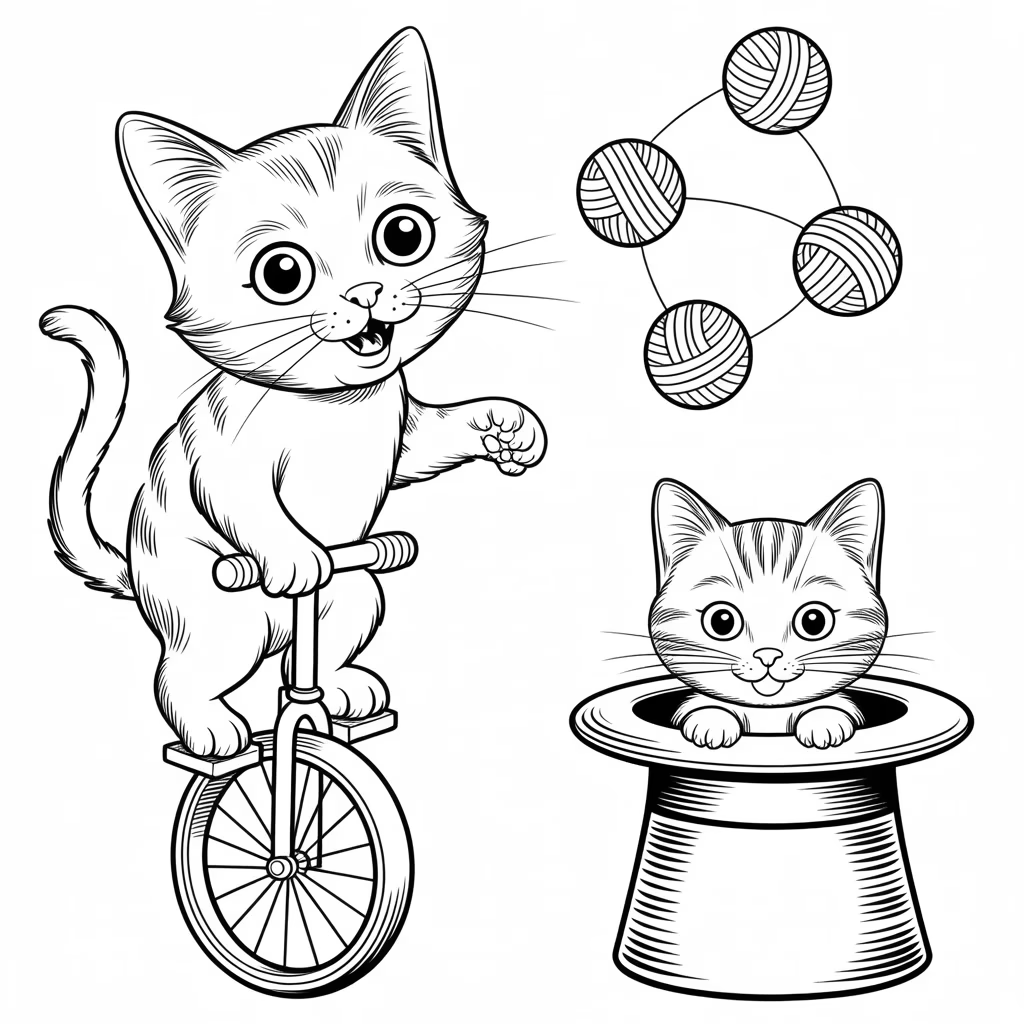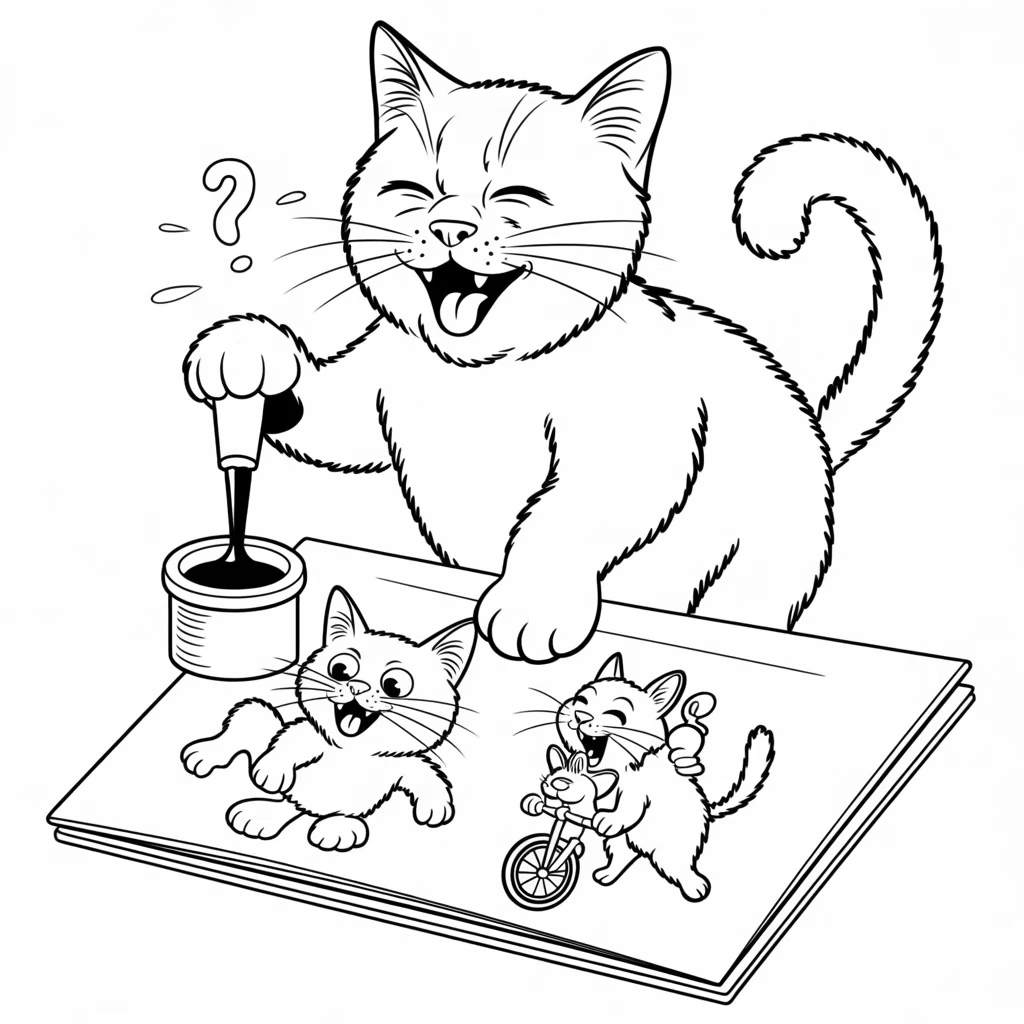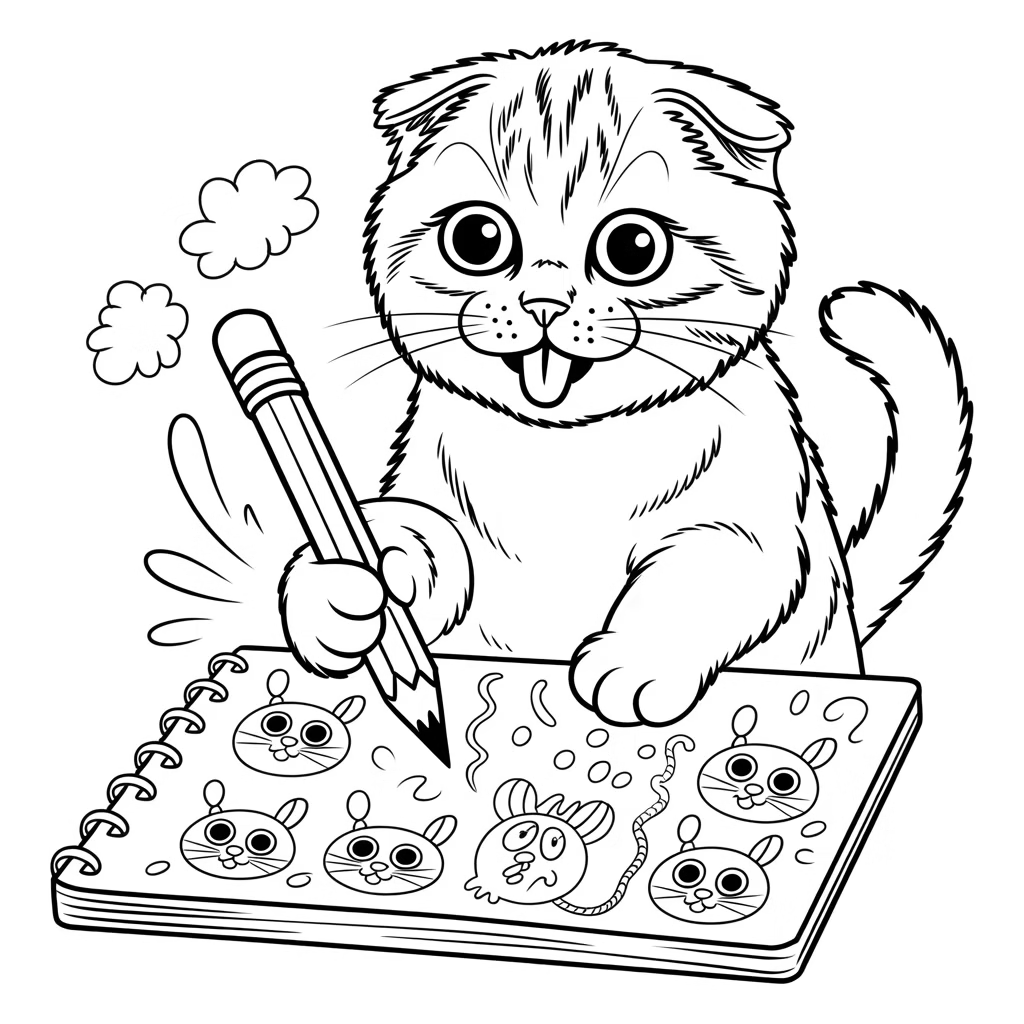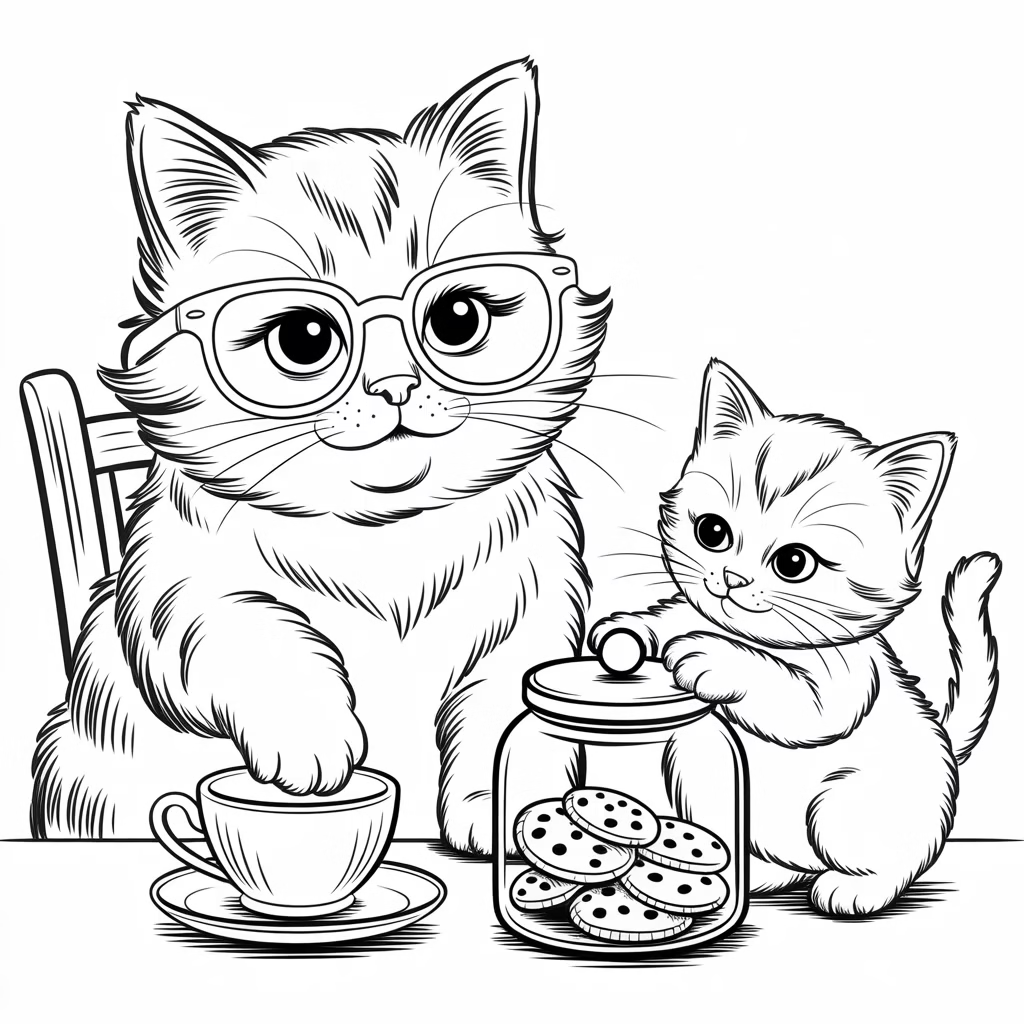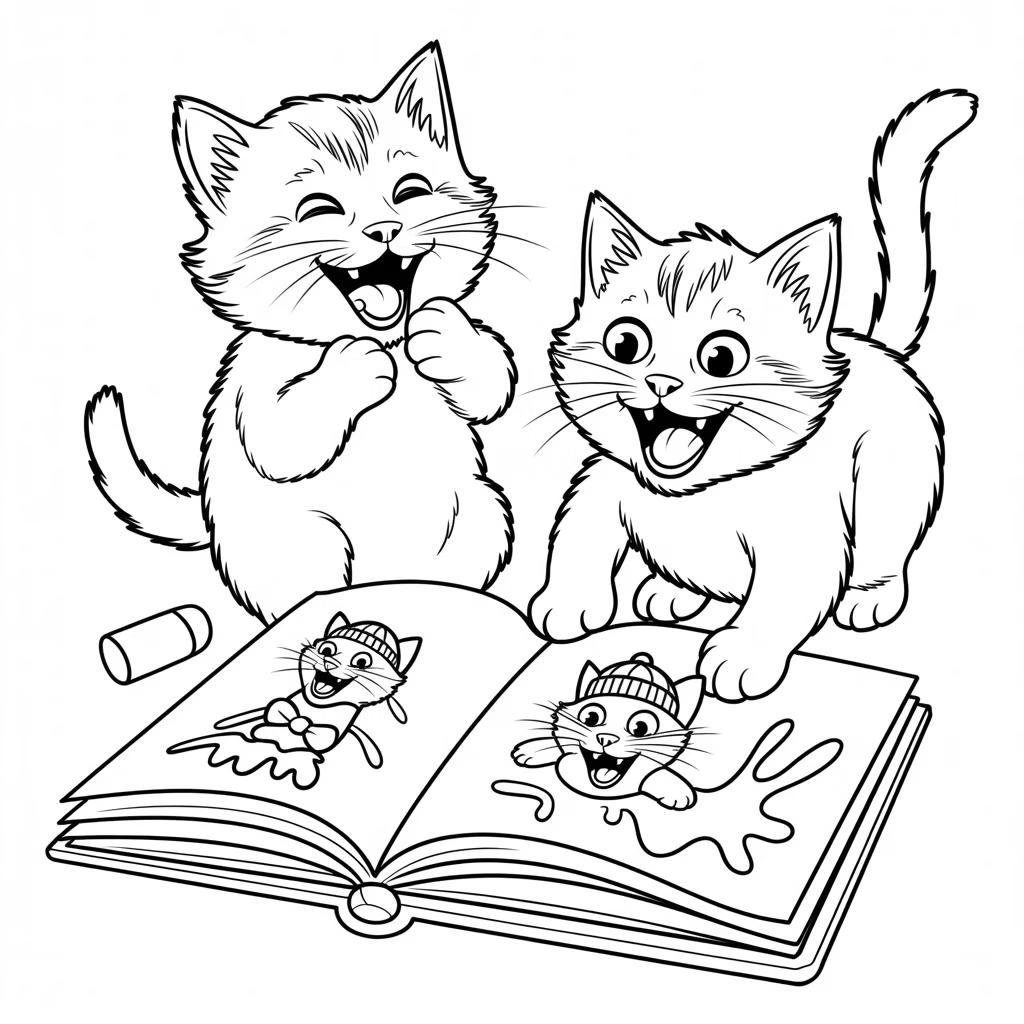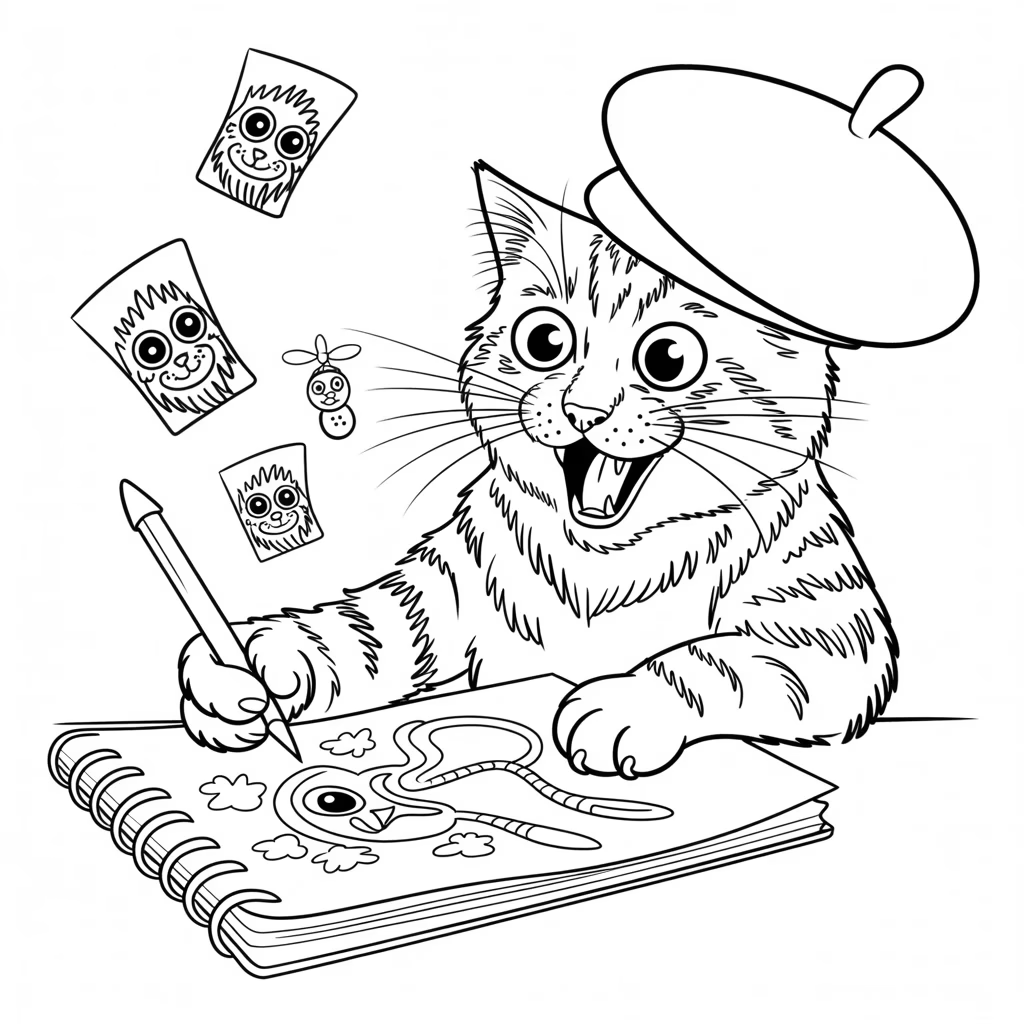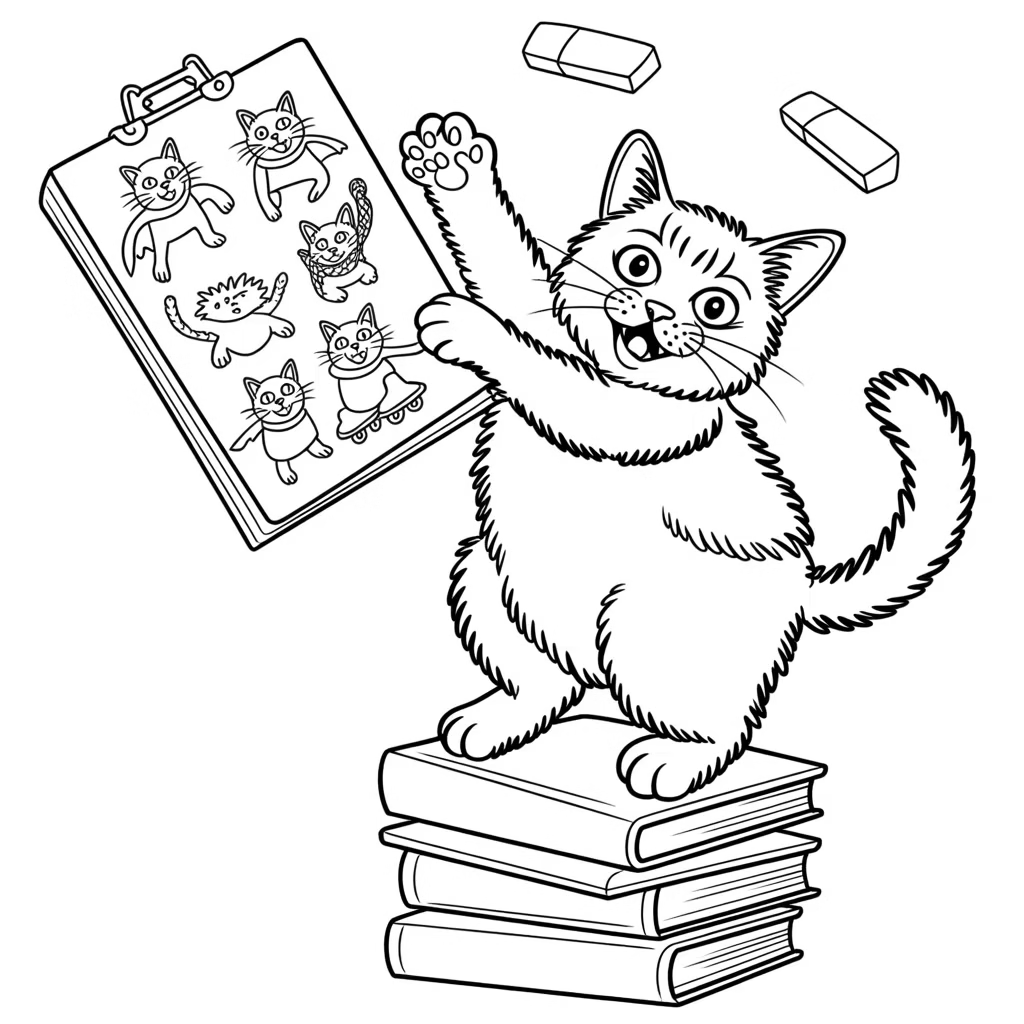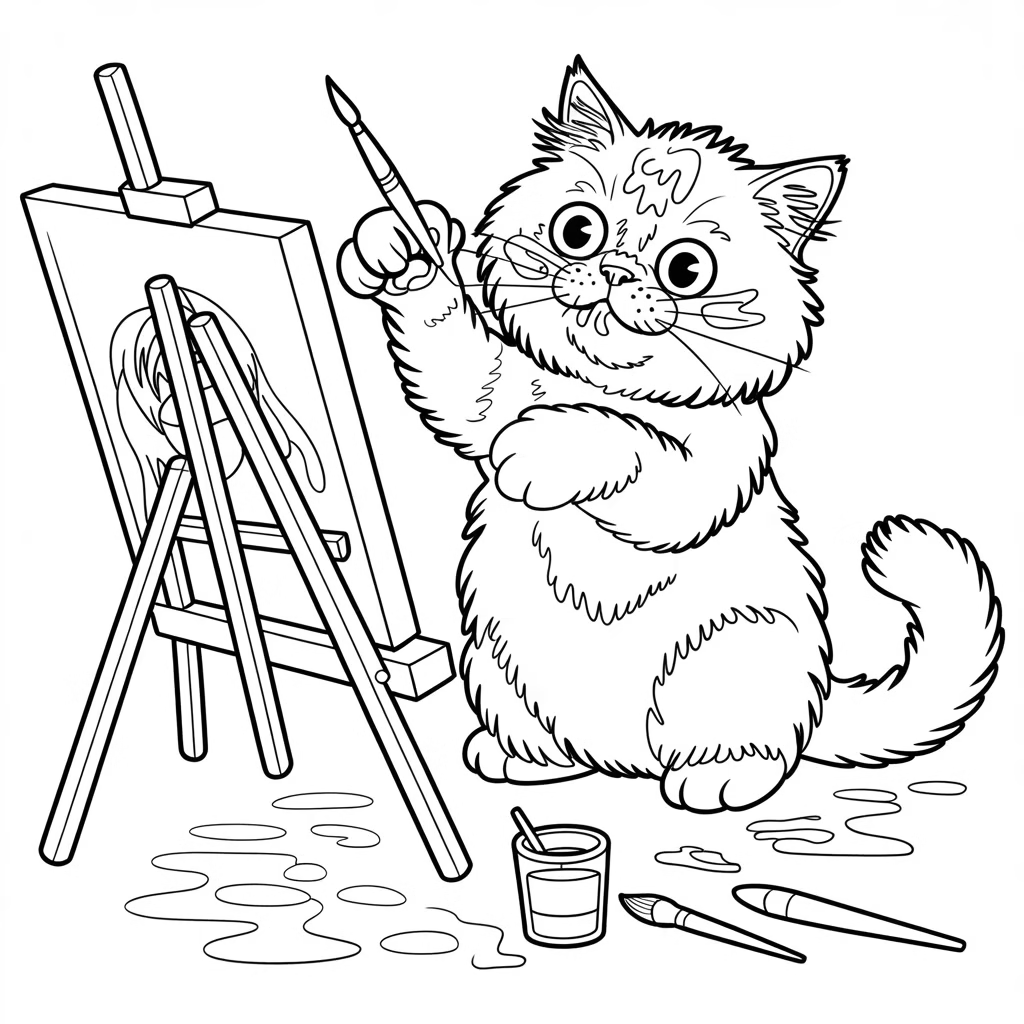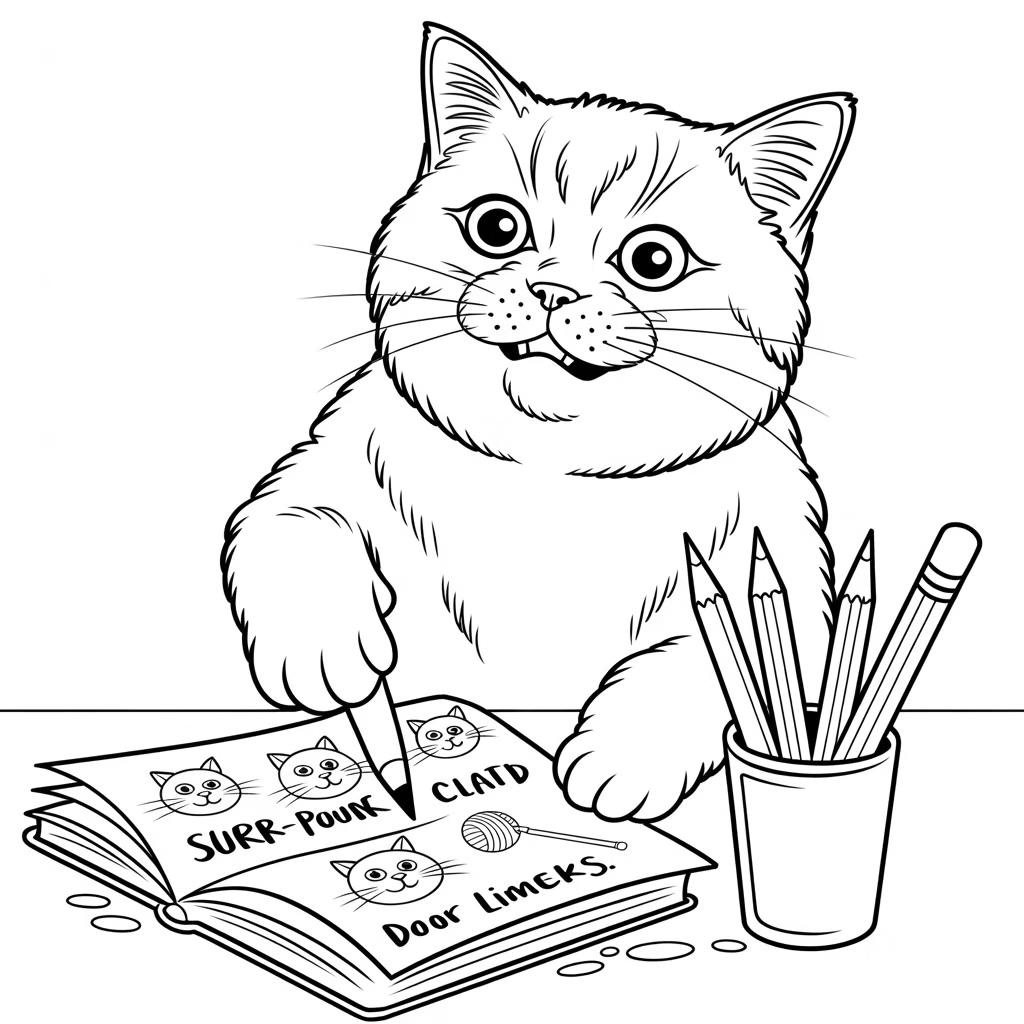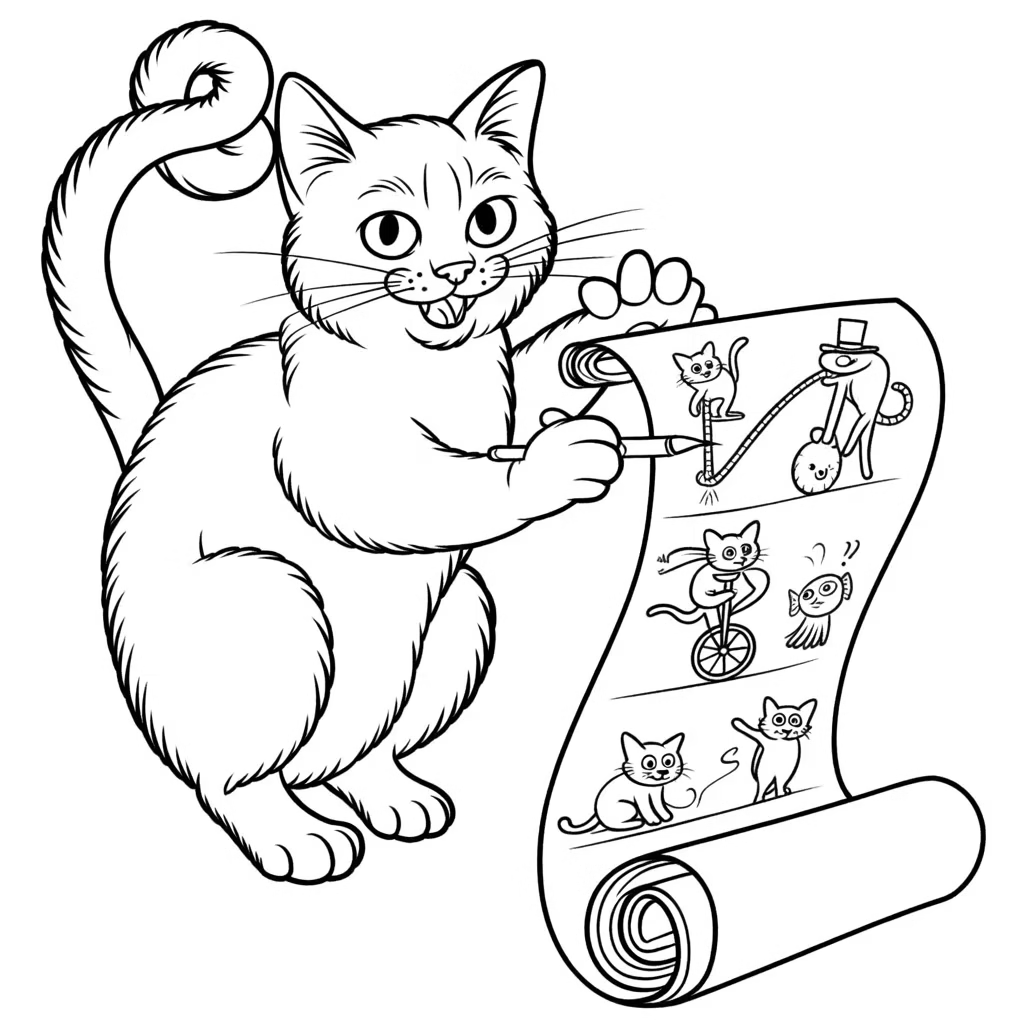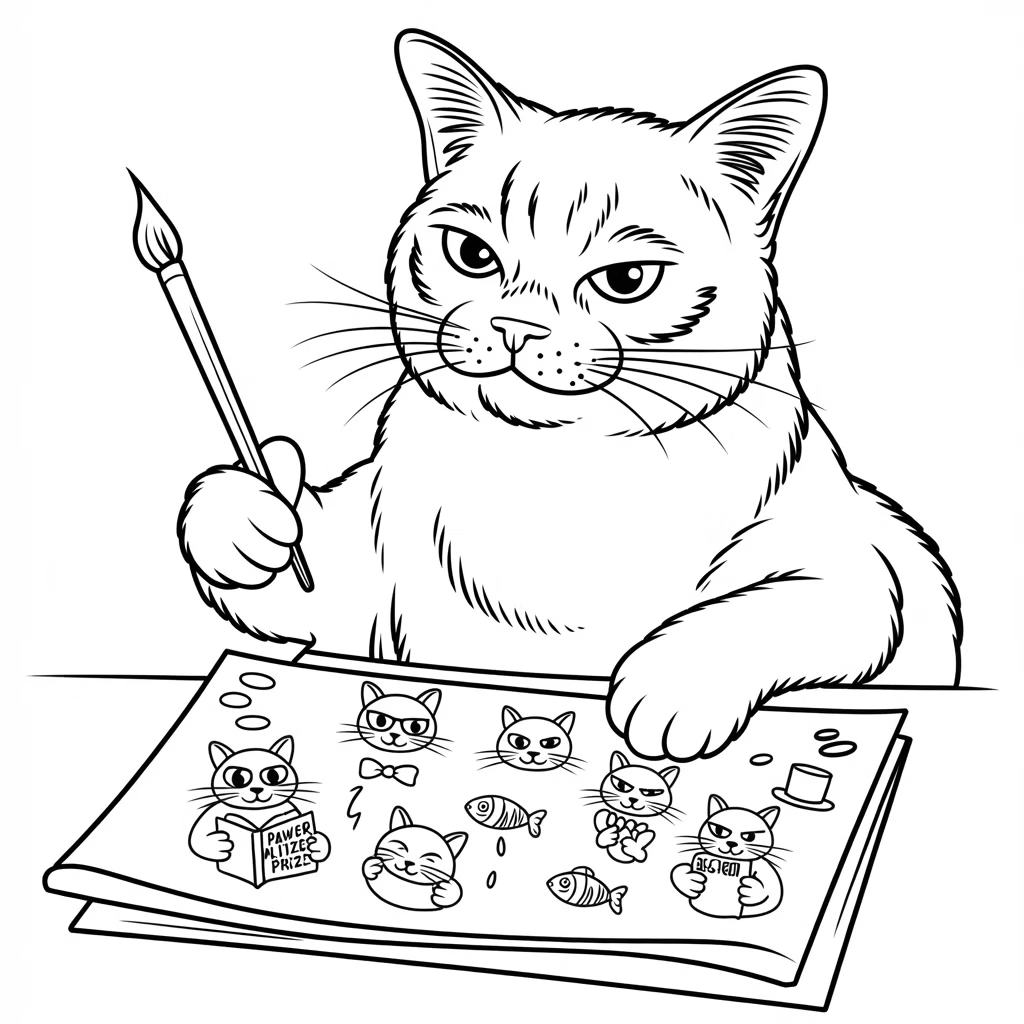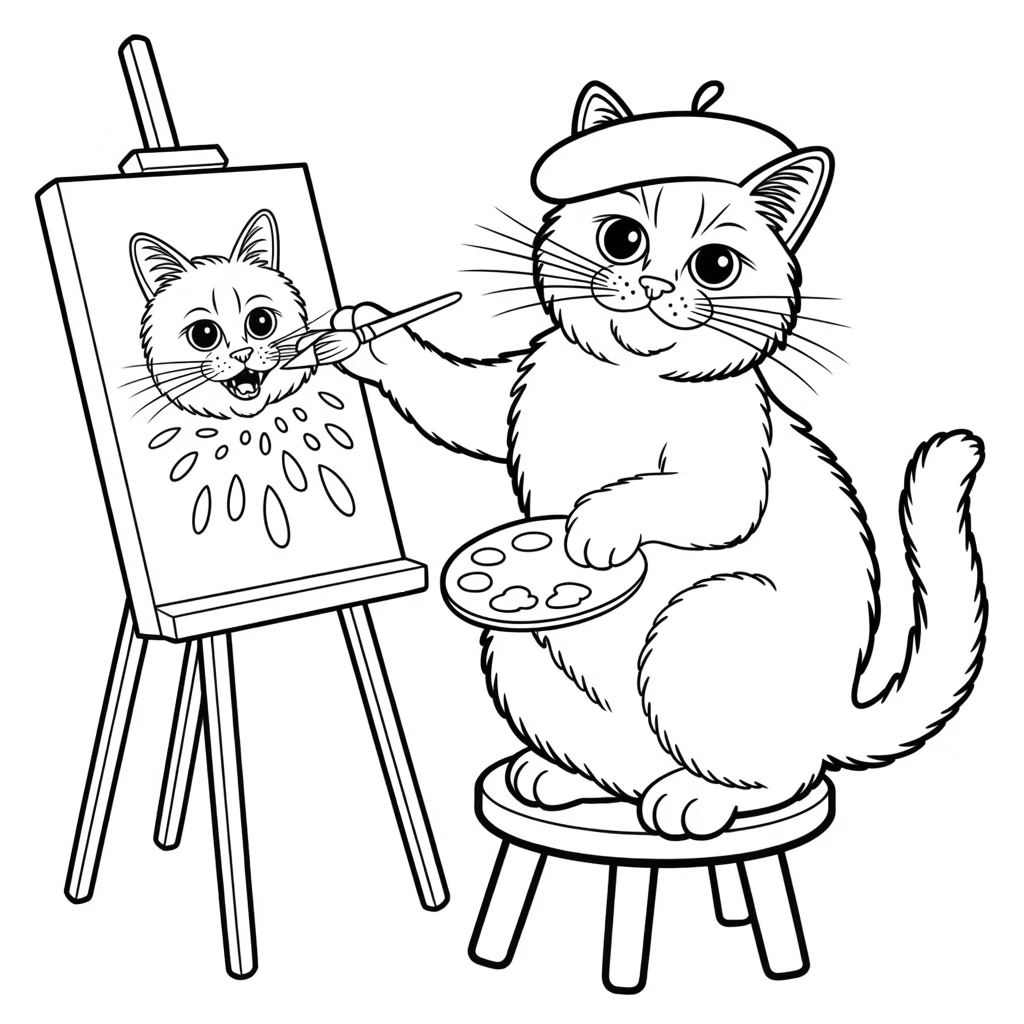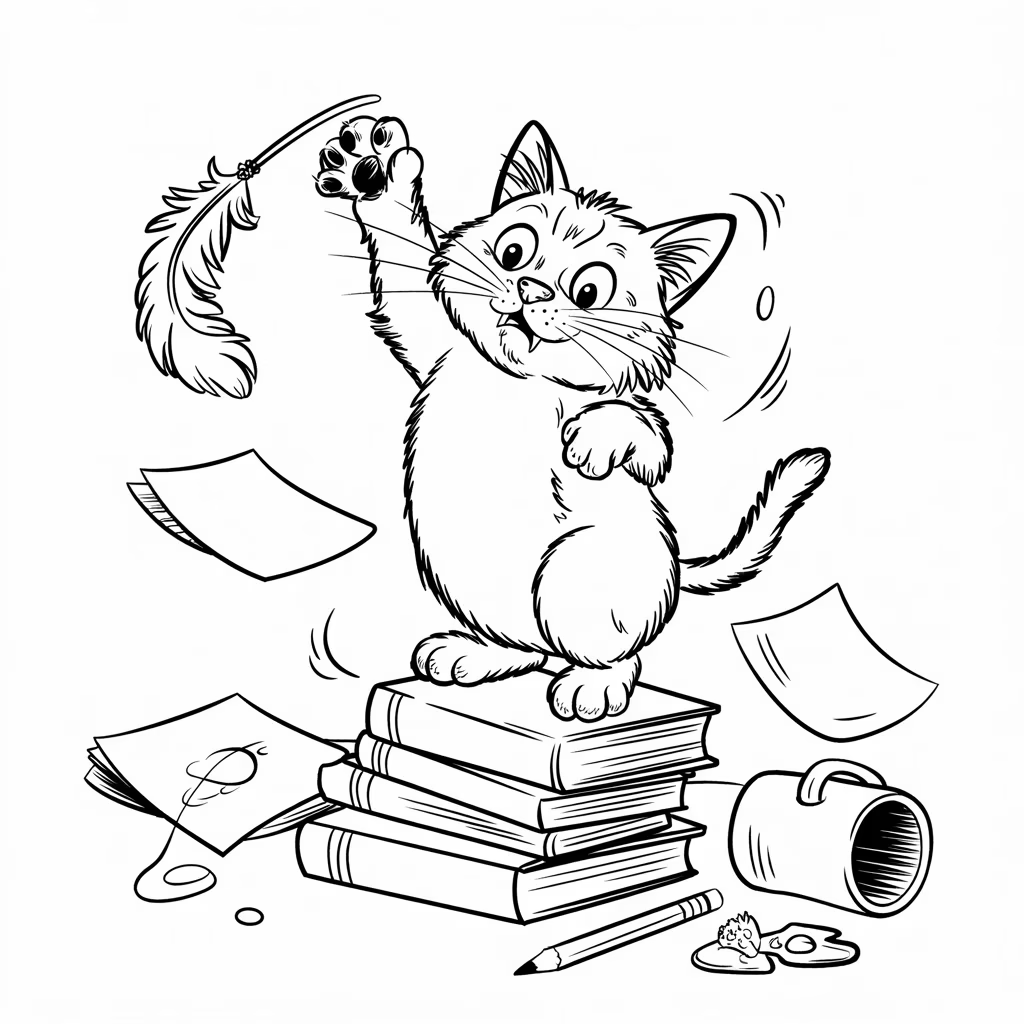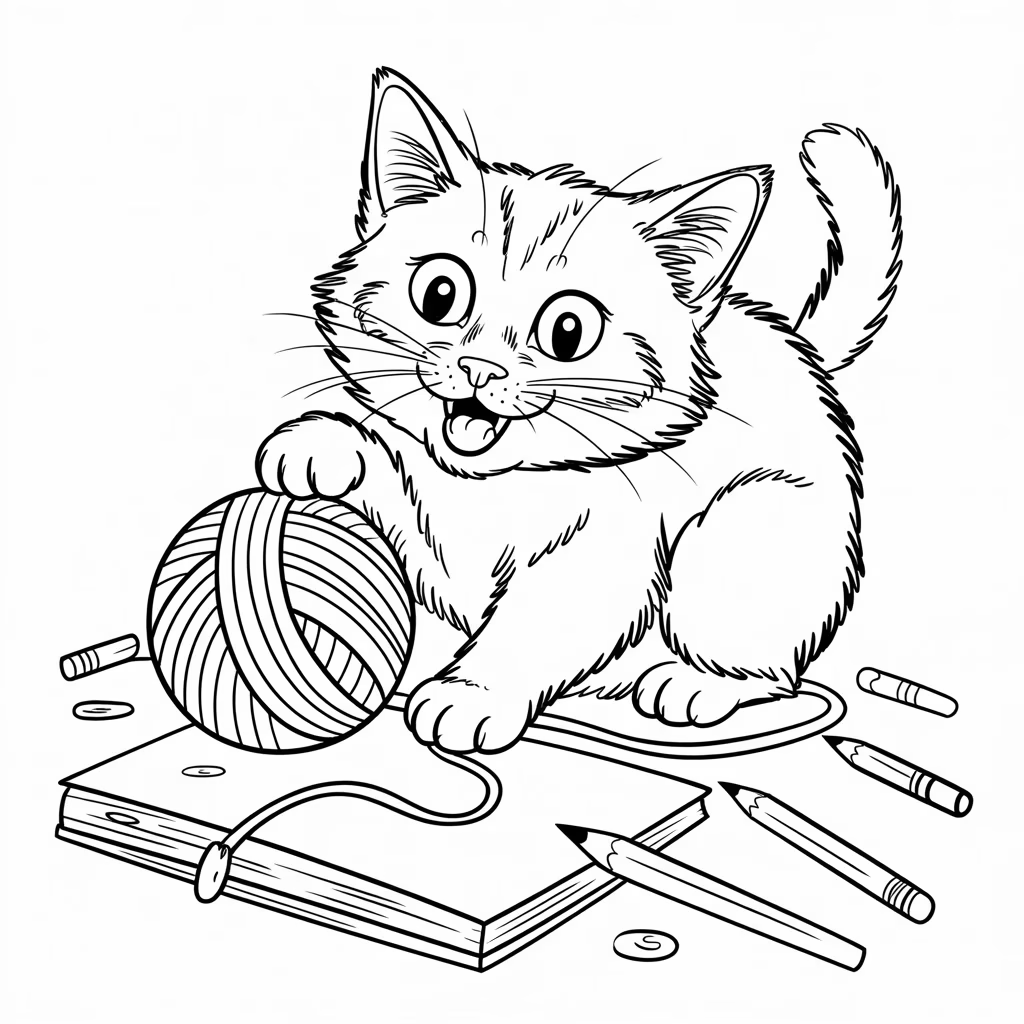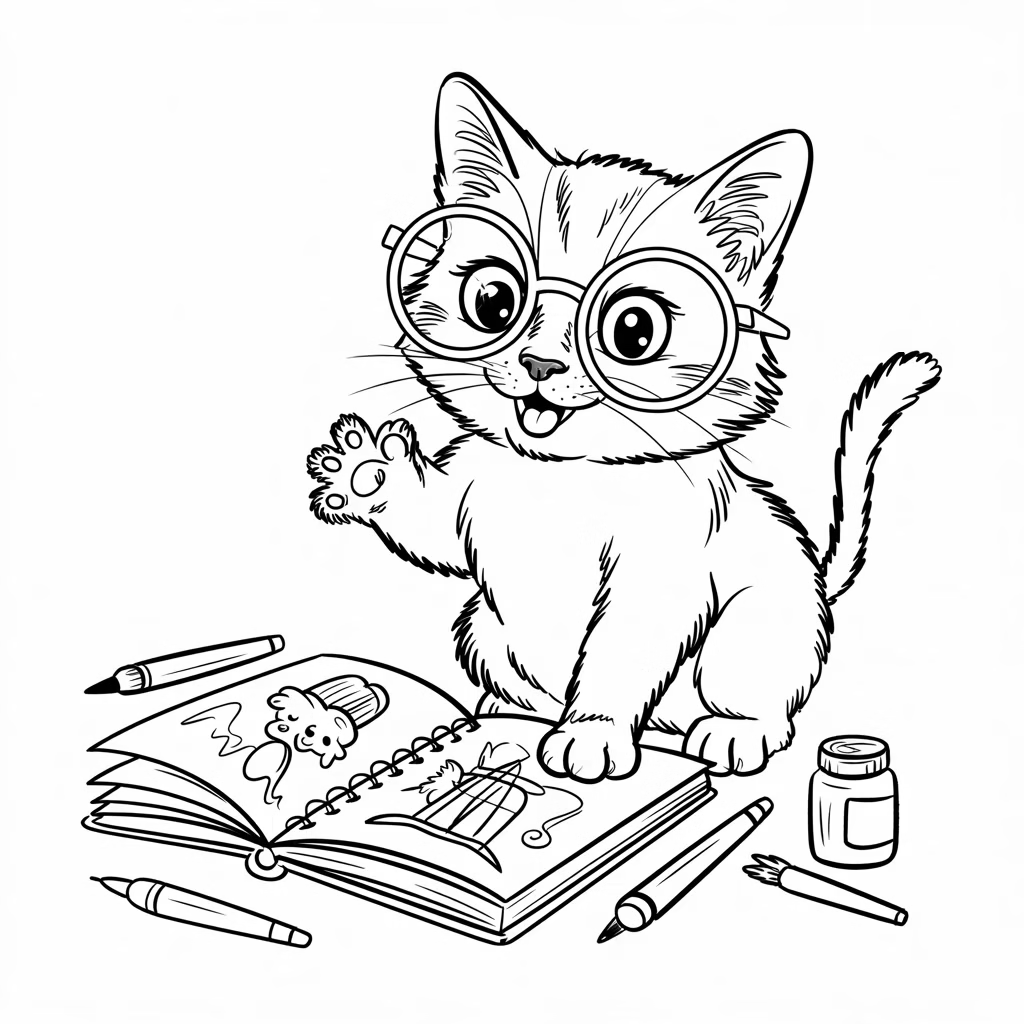Creating amusing cat illustrations begins with capturing the essence of feline playfulness through exaggerated features and lively poses, transforming ordinary cats into delightfully silly characters. Start by sketching fundamental shapes: utilize circles for the head and body, adding triangular ears and a curved tail for a seated or playful position, as demonstrated in basic cat drawing tutorials. To inject humor, enhance expressions—depict wide, sparkling eyes with oversized pupils for a mischievous look, or incorporate sunglasses and party hats for themed enjoyment, such as a summer cat lounging in a pool or a New Year’s party feline. Integrate meme-style sadness with drooping brows and teary eyes, or amplify poses like stretching, scratching, or lounging in ridiculous manners to emphasize comedic traits. Experiment with patterns: polka dots on fur, zigzag stripes on ears, or vibrant rainbow colors for a lively, non-realistic effect, using colored pencils over indented lines for white whiskers that stand out against bold colors. For additional silliness, add props like sparklers, protruding tongues, or hearts in the eyes to elicit laughter. Practice grid techniques to ensure accurate proportions before adding freestyle embellishments, and remember whiskers—three curved lines on each cheek for that quintessential cat charm. Keep in mind, the essence is creativity: blend realistic elements with cartoon exaggeration, such as a cat in a humorous outfit or displaying human-like emotions, to produce engaging, shareable art. Vary line weights for texture—thick outlines for boldness, thin strokes for fur details—and always begin lightly to facilitate easy erasure of mistakes. This method not only enhances skills but also ignites joy in illustrating adorable, comical felines ready for coloring books or social media.
Cat Funny
Cats are the jesters of the natural world, combining eccentric behaviors with a sense of aloof superiority that consistently entertains their human friends. Consider their notorious “zoomies,” those unexpected bursts of frenetic energy where they race around the home like hyperactive squirrels, often at 3 a.m., toppling everything in their path—researchers attribute this to accumulated hunting instincts or simple boredom. Then there is the well-known act of presenting their rear: when a cat pushes its backside into your face, it is not an act of disrespect but rather a friendly sign of trust, marking you as part of their territory with their scent glands. Hissing? It is purely defensive, a theatrical “back off” from an animal that is more frightened than fearsome, while yawning during a confrontation serves as their version of an eye-roll dismissal. Kneading, or “making biscuits,” originates from their nursing habits as kittens, indicating contentment that can transform your lap into a dough-making station. Have you ever witnessed a cat chattering at birds through a window? That is their frustrated predator mode, with jaws clicking in excitement and irritation at prey they cannot reach. They may present you with dead mice or insects as tokens of affection, essentially conveying, “You are family, so partake in my hunt.” Some cats develop peculiar fixations, such as licking items that smell of chlorine, pilfering socks as if they were prey, or insisting on drinking from faucets rather than bowls, considering still water beneath their dignity. Polydactyl cats, with their extra toes, contribute to the amusement, appearing as if they are wearing mittens, while others experience vivid dreams, twitching in their sleep like miniature action heroes. In Japan, cats are honored as potential spirits, and one even achieved the status of stationmaster. With over 100 vocalizations, ranging from meows created specifically for humans to purring that aids in their own bone healing at frequencies of 25-150 hertz, cats ensure we remain entertained. Their selective memory may overlook calls but perfectly remembers the locations of treats, demonstrating that they are the quintessential quirky companions.
Cat Astrophe Comedy
Cats excel at transforming ordinary moments into comical disasters, merging their natural curiosity with a talent for chaos that leaves humans in fits of laughter. Imagine a tomcat trying to intimidate a small kitten: he dashes across the room, leaps onto a table, only to lose his footing on a tablecloth and crash dramatically into a radiator, completely missing his intended target. Alternatively, envision the daring kitten who, during the owner’s bathroom break, driven by curiosity, leaps directly into the toilet while it is in use, emerging soaked and receiving an unplanned bath—the ultimate lesson in the importance of looking before leaping. In another amusing blunder, a cat with recently trimmed claws races around an apartment, forgetting about the slippery floors, and slides sideways into doors or chairs, running in place like a cartoon character, never learning from the repeated accidents over 12 years. Then there is the feline locksmith who, frustrated by a locked door, taps on the outside lock until it secures the humans inside, necessitating neighbors to rescue them with a long pole through a window. Hair-chewing incidents contribute to the humor: one cat confuses a sleeping owner’s bun for a toy, gnawing away until chunks fall out, igniting fears of ghost pranks before the culprit is caught mid-bite. Paralyzed cats zooming in wheelchairs provide heartwarming hilarity, racing around homes with surprising speed. Even mother cats shine in recovery stories, nursing skateboarding kittens back to health after tumbles, offering gentle care amidst the absurdity. Polydactyl kitties with extra toes stumble as if they are wearing mittens, while others present
Catnip Craziness
Catnip, a remarkable herb from the mint family scientifically referred to as Nepeta cataria, incites a whirlwind of excitement in approximately 60-70% of cats. This reaction is attributed to its powerful compound, nepetalactone, which mimics pheromones and disrupts their sensory perception. When a sensitive cat detects the scent through their vomeronasal gland—a unique olfactory organ located in the roof of their mouth—it initiates a dramatic behavioral display, transforming even the most lethargic feline into an energetic acrobat. Imagine your cat suddenly rolling joyfully on the floor, rubbing its cheeks against everything nearby, purring like a motorboat, and racing around in euphoric bursts of energy, possibly accompanied by playful aggression or affectionate head-butts. Some cats may lick and chew obsessively, shake their heads in delight, or pursue imaginary adversaries, showcasing pure “catnip craziness” that endures for a brief 5-15 minutes before olfactory fatigue sets in, rendering them temporarily unresponsive for up to two hours. When ingested, the effects are reversed, often leading to a calm, dreamy state where they relax into a state of blissful contentment, grooming more frequently or vocalizing softly. Not every cat participates in this phenomenon—kittens younger than 3-6 months and about one-third of adult cats lack the genetic predisposition, showing no response, while older cats may exhibit a mild reaction. Generally safe for most felines, catnip can alleviate boredom, assist in training by attracting them to scratching posts, or reduce stress during veterinary visits; however, excessive consumption may lead to mild stomach upset, so it is advisable to supervise their sessions. This herbal high, which can evoke everything from hyperactivity to serene affection, elucidates why catnip toys and sprays are so popular among cats, providing endless entertainment for owners who observe their pets morphing into whiskered whirlwinds of joy. Ultimately, the eccentricity of catnip underscores the unique neurology of cats, merging evolutionary hunting instincts with fleeting madness that keeps the pet world perpetually amused.
Cat Tastic Comedy
Cats exemplify “cat-tastic comedy” through their endlessly amusing behaviors, merging aloof charm with slapstick antics that transform ordinary days into laugh riots. Begin with the classic “zoomies,” where felines suddenly dash around like furry lightning bolts, crashing into furniture in a frenzy of pent-up energy, often triggered by nothing more than a random shadow or a burst of energy after a nap. Next is head bunting: your cat rams their forehead into yours, not out of aggression but as a pheromone-laden “I own you” love tap, marking you as their territory while appearing utterly ridiculous. Chattering at birds through windows adds to the hilarity—their jaws clack in frustrated excitement, mimicking the act of capturing prey but achieving zero results, akin to a comedian failing on stage. Kneading, or “making biscuits,” involves them pawing at your lap with rhythmic intensity, a nostalgic behavior from kittenhood that can become painful if claws are involved, all while they purr contentedly. Do not overlook the ankle attacks: bored cats ambush your feet like stealthy ninjas, pouncing from hiding spots for no reason other than mischief. Tail twitching indicates annoyance, serving as a subtle warning that can escalate to swats if ignored, while exposing their belly invites a rub only to unleash a surprise grapple. Some cats chew on unusual items like socks or plastic, driven by anxiety or early weaning, risking blockages in their quest for peculiar comfort. Nighttime howling combines hunger with their natural crepuscular habits, serenading you at dawn for food puzzles. Felines “bury” their food by pawing around their bowls, an instinctual cover-up fail in modern kitchens. Bringing “gifts” of dead critters demonstrates affection, though it horrifies their owners. Even staring with open mouths—flehming scents through their Jacobsen organ—resembles a grimace of judgment. These quirks, ranging from citrus aversion to chlorine obsession, underscore the unique neurology of cats, rendering them perpetual sources of whiskered wit and viral videos.
Claws And Giggles
Cats’ claws serve as the quintessential instruments for “claws and giggles,” turning ordinary feline antics into uproarious comedy that brings joy to pet owners around the globe. These sharp appendages are not solely for protection or climbing; they are the protagonists of numerous amusing blunders, such as when an inquisitive kitty swipes at a dangling string, only to ensnare itself in a chaotic yarn ball skirmish, emerging resembling a fuzzy mummy. Scratching behaviors contribute to the amusement—cats assert their territory by clawing at furniture, leaving behind pheromone trails and visible shreds, often selecting your beloved couch as their canvas, transforming it into a tattered masterpiece while stretching luxuriously as if auditioning for a yoga class. Playful swats during games can escalate into comedic chases, with retracted claws ensuring safety among felines, but humans should be cautious: an overly enthusiastic paw might draw blood during affectionate roughhousing, leading to exaggerated yelps and swift retreats. In viral videos, cats assert their territory by standing tall, paws flailing as if they are playing an invisible bass guitar, or grappling with stubborn clothing that refuses to budge, culminating in defeated flops. Some cats develop peculiar habits, such as clawing at legs for attention, which can lead to injuries and infections, yet responding with dramatic fake sobs or employing clicker training can mitigate the chaos without resorting to punishment. Even the act of grooming becomes humorous—shedding outer nail sheaths leaves behind tiny remnants akin to crime scenes, while vigorous scratching alleviates stress, flexing their spines in ecstatic poses. Threatening swipes during play rarely injure fellow cats, thanks to their thick fur, but inter-cat altercations may necessitate veterinary visits for abscesses. Obsessive scratchers target unusual locations, from doors to drapes, inadvertently finding themselves in predicaments like being stuck in curtains. For indoor cats, providing robust scratching posts mimics the rituals of outdoor tree-trunk scratching, preventing destructive behaviors while promoting healthy nail maintenance. Ultimately, these claw-centric escapades underscore the mischievous nature of cats, intertwining instinctual needs with sheer delight.
Feline Follies
Feline follies capture the amusing and unpredictable behaviors that establish cats as the unrivaled jesters of the animal realm, transforming ordinary moments into laugh-inducing spectacles. From the notorious zoomies—unexpected surges of frenetic energy where they dash like furry missiles, colliding with walls or furniture in a whirlwind of unseen chases—to chattering at birds through windows, their jaws clicking in exasperated excitement as if devising an unattainable heist, cats provide us with endless amusement. Kneading, or “making biscuits,” involves them rhythmically pawing at blankets or laps, a comforting reminiscence of their kitten days that frequently escalates into clawing mayhem, leaving owners with torn garments and bemused smiles. Head bunting introduces affection with a twist: a solid forehead nudge releases pheromones, marking you as theirs while appearing adorably possessive. Presenting “gifts” such as dead mice or insects is their method of sharing the hunt, although it horrifies humans who receive these gruesome tokens of affection. Chewing on peculiar items—socks, plastic bags, or even chlorine-scented objects—arises from boredom or anxiety, posing risks of blockages but generating viral videos of their quirky habits. Rubbing against everything signifies territory marking with cheek glands, a proud ritual of “this is mine” that includes your legs during conversations. Displaying bellies invites rubs, only to provoke surprise swats, while tail movements indicate annoyance, not joy as seen in dogs. Some cats groom their owners’ hair after showers or drink from faucets, disregarding bowls in favor of “fresher” alternatives. These behaviors, ranging from allogrooming companions to hiding in small boxes for comfort, underscore cats’ eccentric instincts—crepuscular night hunters who pounce on ankles or unravel toilet paper with gleeful havoc. Ultimately, feline follies intertwine affection, mischief, and enigma, demonstrating why these whiskered mysteries reign over internet humor and our hearts.
Furry Funhouse
Cats turn typical homes into a “furry funhouse” with their playful antics, merging predatory instincts and limitless energy to provide endless amusement for their owners. Originating from hunting simulations, feline play often includes chasing and pouncing, where kittens stalk toys or siblings with dramatic leaps, imitating wild pursuits that refine their motor skills and strengthen social connections. When playing alone, cats may bat at strings or feather wands, performing acrobatic flips or hiding behind objects like paper bags to set up ambushes, their tails twitching with excitement as they tap into their predatory nature. Social interactions enhance the humor: littermates engage in wrestling with belly-up rolls and gentle nibbles, retracting their claws to prevent injury, which fosters trust while resembling fluffy tumbleweeds caught in a whirlwind. Object play consists of tossing and capturing items, with success rates of one in three to six attempts maintaining their interest—tasks that are too easy lead to boredom, while those that are too difficult can cause frustration. Hunger amplifies these playful behaviors, diminishing fear of larger toys and enhancing their predatory instincts, although play remains separate from actual feeding. In households with multiple cats, it is crucial to differentiate play from fighting: relaxed postures, smooth movements, and mutual engagement indicate fun, whereas tense stares or flattened ears suggest aggression. Indoor cats particularly benefit from interactive play sessions with wands or laser pointers to alleviate boredom and prevent play aggression, as overstimulation can result in bites or swats at ankles. These behaviors evolve from the high-energy romps of kittenhood to the more selective games of adulthood, yet all ages thrive on play for mental stimulation and physical exercise. Even the bond between humans and cats is strengthened through daily play sessions, with cats showing a preference for varied toys that mimic fleeing prey rather than confrontational ones. In this funhouse filled with whiskers and paws, every pounce and chase transforms living rooms into joyful arenas, demonstrating that the playful nature of cats keeps the household vibrant and filled with laughter.
Giggle Whiskers
Giggle Whiskers springs to life whenever a cat’s face contorts into expressions that rival those of stand-up comedians, demonstrating that felines are anything but inscrutable. With a collection of nearly 276 unique facial signals, cats surpass dogs and even some primates in the art of silent storytelling. A twitch of whiskers angled forward exclaims “game on,” while a sudden flattening of ears signals stagehands to clear the set. Their signature slow blink serves as the ultimate punchline: a languid, trust-filled “I’m cool with you,” inviting audiences to reciprocate the wink for immediate rapport. Dilating pupils expand like spotlights when play becomes dramatic, yet constrict to mere slits in a display of victorious swagger. Researchers observe that friendly expressions dominate performances, making up approximately forty-five percent of the routines, while aggressive grimaces account for thirty-seven percent of the show. Between acts, whiskers relax into gentle curves, ears swivel like boom microphones, and a content muzzle signals the house lights to dim. However, even off-script improvisations keep viewers entertained: a nose lick following a failed pounce, or a jaw-dropping yawn that transitions from boredom to exuberance in mere seconds. In this whiskered comedy club, every eyebrow raise, ear swivel, and whisker wiggle delivers its punch, reminding us that cats convey a wealth of information without uttering a single meow—unless the treat jar remains unopened, at which point the heckling resumes with theatrical trills and chirps, ensuring encore snacks and endless laughter for their adoring audience. Curtain call: the feline funny bone remains undefeated, and the giggles continue, whiskers twitching triumphantly tonight as well.
Kitty Capers
Kitty antics transform typical homes into obstacle courses as cats embrace their curiosity, agility, and a hint of disorder. A sudden bout of the zoomies propels them racing down hallways, bouncing off furniture in bursts of pent-up energy that researchers associate with crepuscular hunting instincts. Moments later, the same feline might settle on a shelf, leisurely swatting trinkets to the ground to experiment with gravity and gauge audience reactions, a behavior stemming from exploratory paw play. Scratching beloved sofas serves a dual function—marking territory with pheromones while shedding outer claw sheaths—though to humans, it appears as joyful vandalism. Some explorers nibble on forbidden houseplants, motivated by texture and boredom, even if the foliage ends up partially chewed and the perpetrator sporting a leaf moustache. Others orchestrate heists, pilfering chicken thighs or bakery buns from countertops because instinct dictates that unattended food is fair game for a stealthy predator. As dawn breaks, proud hunters leave “gifts” of toy mice—or real insects—on pillows, an ancient method of sharing their bounty with their social group. Laptop-blocking sit-ins illustrate strategic mischief: by occupying whatever humans are focused on, cats ensure they receive attention while simultaneously spreading their scent. Even litterbox refusals can be capers in disguise; stress or substrate grievances prompt dramatic protests outside the box until management meets feline expectations. Through every ankle ambush, curtain ascent, and midnight serenade, these whiskered tricksters remind us that mischief is instinctual, endlessly creative, and utterly captivating to their amused human companions—delightfully chaotic, yet irresistibly charming for all involved each day.
Kitty Quirks
Cats are mysterious beings, each possessing a distinct array of idiosyncrasies that render them perpetually intriguing. At one moment, they assume the role of sovereigns within the home, reclining on the highest vantage point with an air of superiority; in the next, they may be seen pursuing their own tails or leaping at an unseen adversary, showcasing their playful and almost ludicrous nature. My cat, Luna, exhibits a strange fascination with cardboard boxes, converting any package into her own stronghold, where she can remain for hours, glaring like a diminutive monarch. Then there are the midnight zoomies—those inexplicable surges of energy during which she dashes through the house, colliding with walls without any consideration for the laws of physics. Cats also possess an uncanny ability to locate the one area you wish for them to avoid, such as the keyboard you are currently using or the precise center of a freshly made bed. Their penchant for knocking items off tables appears less as mere mischief and more as a calculated experiment in gravity. The vocalizations of cats vary significantly: some emit chirps reminiscent of birds, while others yowl as if they are preparing for an operatic performance. Luna’s trademark expression is a gentle, inquisitive “mrrp” when she is caught in the act of mischief, as though she is genuinely bewildered by my disapproval. And I could go on about their staring contests with walls—no one can ascertain what they perceive, but it is evidently profound. These peculiarities, ranging from their particular food preferences to their strange sleeping positions, are what render cats such charming and unpredictable companions, infusing chaos and allure into every moment.
Laughing Kitties
Cats possess an extraordinary ability to transform the ordinary into moments of sheer hilarity, their peculiar behaviors eliciting laughter even from the most cantankerous individuals. Consider my cat, Muffin, who appears to believe that every plastic bag is a formidable foe, launching into theatrical ninja flips to ‘vanquish’ it, only to become ensnared and freeze, wide-eyed, as if betrayed by her own courage. Then there is the quintessential cat-in-a-box act—provide them with a cardboard square, and they will cram themselves inside, regardless of how absurdly small it may be, gazing triumphantly as if they have scaled Everest. Their bursts of energy are the pinnacle of comedy: one moment, they are dozing like furry royalty; the next, they are racing through the house, leaping over furniture, and colliding with walls in a manner that exclaims, ‘I intended to do that!’ Cats also excel in the art of the stink-eye, glaring at you for the audacity of moving their cherished toy or, even worse, for not sharing your sandwich. Muffin’s signature routine is her ‘silent meow’—mouth agape, devoid of sound, radiating pure, sassy attitude. And who can resist their fascination with toppling objects off tables? It is not chaos; it is a performance, each item sent soaring with a flick of the paw and a gaze that communicates, ‘What? Gravity did it.’ Whether they are pursuing laser pointers with the concentration of an Olympian or dramatically flopping for a belly rub they will promptly reject, cats like Muffin ensure we remain amused, their unpredictable antics providing a daily dose of absurd, delightful joy.
Meow Madness
Cats are the unrivaled masters of chaos, and their “meow madness” episodes are a whirlwind of feline absurdity that provides us with endless amusement. My cat, Whiskers, has a tendency to burst into spontaneous sprints at 3 a.m., bouncing off furniture like a furry pinball, his eyes wide with a frenzied glint as if he is pursuing phantoms that only he can perceive. Additionally, he is fixated on paper balls—throw one, and he will leap over couches, crashing into spectacular wipeouts, only to walk away as if nothing occurred. Cats transform the mundane into performance art: a stray sock becomes a formidable adversary, subdued with theatrical flops. Whiskers’ meow collection is a cacophony of madness, ranging from demanding yowls at an empty food bowl to chirpy trills upon spotting a fly, his tail twitching like a metronome gone awry. The quintessential cat stare-down with a blank wall epitomizes lunacy—what cosmic mysteries are they unraveling? Moreover, one cannot ignore their talent for occupying the most inconvenient locations, such as sprawling across your laptop during work, challenging you to contest their dominion. Whiskers’ crowning achievement? Deliberately knocking my coffee mug off the table with a calculated paw swipe, then strolling away with a self-satisfied “meow” as I rush to tidy up. From tearing apart curtains to treating hair ties as coveted trophies, cats like Whiskers exemplify meow madness—a delightful fusion of mischief, audacity, and charm that transforms every day into a comical, unpredictable escapade.
Meow Velous Mayhem
Cats are the masters of delightful disorder, creating chaos with a style that is both exasperating and completely captivating. My tabby, Gizmo, excels in this craft, transforming our home into a venue for his exuberant performances. At dawn, he leaps onto the bed, landing directly on my chest with a victorious “meow,” as if asserting his claim over me as his throne. His fascination with shoelaces is extraordinary—any dangling string incites a flurry of pouncing, accompanied by somersaults and a tangle of paws that leaves him blinking in feigned bewilderment. Gizmo’s bursts of energy are legendary, a whirlwind of fur racing through the house, skidding across the kitchen floor, and occasionally colliding with a chair, producing a thud that proclaims, “I’m fine!” His vocal abilities contribute to the chaos: from deep growls directed at a daring moth to a high-pitched “mow-wow” when he requests treats. Additionally, he has a penchant for knocking pens off my desk, each one propelled into the air with a deliberate paw flick and a self-satisfied look that seems to say, “Your move, human.” Cardboard boxes? They become instant fortresses where he schemes for world domination, only to doze off mid-plot. The true wonder is how Gizmo’s chaos appears to be choreographed—one moment he’s tearing apart a stray napkin, the next he’s curled up, purring like a little angel. This delightful mayhem, with its mix of mischief, confidence, and charm, transforms every day with Gizmo into a hilarious, heartwarming spectacle.
Purr Fectly Hilarious
Cats are the quintessential comedians, providing perfectly amusing moments with remarkable ease. My ginger cat, Simba, is a solo feline comedy act, transforming each day into a riot of laughter. His preferred trick? Ambushing my feet from beneath the couch, launching a surprise attack with a theatrical “mrow!” before dashing away, his tail fluffed as if he has just escaped from a lion. Simba’s fascination with empty paper towel rolls epitomizes absurdity—he will bat one across the floor, pursuing it with ninja-like spins, only to become trapped inside and emerge with a perplexed expression. His zoomies strike like a whirlwind, propelling him over furniture, skidding into walls, and then pausing mid-run to groom a paw as if nothing occurred. The manner in which he yowls at a closed door, insisting on entry, only to stroll away when I open it, is pure feline mischief. Simba’s talent for knocking my glasses off the nightstand resembles a calculated stand-up performance—each crash followed by a self-satisfied glance. And I could go on about his “silent meow” act, mouth wide open in a dramatic, soundless request for treats. Whether he is wrestling a stray sock into submission or gazing intently at a blank ceiling, Simba’s antics are a masterclass in chaos and charm. These perfectly amusing moments—equal parts mischief and innocence—render living with him a daily source of laughter, demonstrating that cats are nature’s greatest pranksters.
Purr Sonal Jokes
Cats are inherently humorous creatures, crafting personal jokes through their daily behaviors that leave us in fits of laughter. My cat, Tinker, is a fluffy comedic talent, delivering punchlines with each playful action. What’s her favorite routine? Sneaking onto my desk and swatting my pen to the ground, then giving me a wide-eyed “Who, me?” look as if I’m the one at fault. Tinker’s fascination with plastic bottle caps serves as a recurring joke—she will chase one across the room, darting and spinning like a feline ice skater, only to misplace it under the fridge and meow at me in accusation to retrieve it. Her vocal range is a treasure trove of comedy: a cheeky “mrrrow” when I dare to pet her for too long, or a cheerful trill when she “hunts” a dust bunny. The sight of her squeezing into shoeboxes that are half her size, with her legs spilling out like a cartoon character, is a visual gag she never seems to tire of. The midnight zoomies hit with Tinker dashing down the hallway, leaping over the cat tree, and crashing into a pillow with a thud that exclaims, “Nailed it!” Her ultimate prank? Swiping my phone off the table during a call, then strolling away with a self-satisfied flick of her tail. From engaging in staring contests with her own reflection to performing dramatic flops for attention, Tinker’s personal jokes create a delightful mix of cleverness and playfulness, transforming each day into a comical and heartwarming show.
Tail Twisting Tales
Cats create captivating narratives with each flick of their expressive tails, spinning tales of mischief and charm that hold our attention. My cat, Shadow, excels as a storyteller, his tail serving as a furry quill that scripts daily doses of chaos. One moment, it is raised high, indicating confidence as he confidently strides onto my laptop, claiming it as his stage; the next, it thrashes wildly as he engages in a fierce battle with a rogue feather toy, flipping and tumbling like an acrobat in a feline fable. Shadow’s tail-twisting narratives feature his obsession with yarn balls—each one portrayed as a villain in his epic saga, pounced upon with such drama that one might think he is saving the world. His legendary midnight zoomies see his tail whipping like a rudder as he dashes through the house, skidding into corners with a crash and a bewildered “mow.” Shadow’s vocalizations enrich his stories: a low growl when a squirrel taunts him through the window, or a chirpy “mrrp” when he presents me with a crumpled leaf. The slow, deliberate swish of his tail as he knocks my keys off the counter is a plot twist I never anticipate. Whether he is gazing at walls, chasing his own tail in a dizzying loop, or curling it around his paws for a regal nap, Shadow’s tail-twisting tales are a whirlwind of humor and heart, with each flick and twitch crafting an unpredictable, perfectly enchanting narrative.
Whisker Wit
Cats utilize their whiskers as if they were wands of humor, creating instances of pure brilliance that leave us laughing at their clever behaviors. My cat, Pepper, is a comedian armed with whiskers, each of her movements exuding feline elegance. With a flick of her whiskers, she focuses on a stray sock, leaping with the accuracy of a stand-up comedian delivering a punchline, only to display it triumphantly like a trophy. Pepper’s whisker humor is particularly evident during her covert ambushes—she conceals herself behind the curtain, her whiskers trembling with excitement, then springs forth to ‘startle’ me, her self-satisfied ‘mrrrow’ confirming the joke. Her fascination with plastic straws is nothing short of brilliant; she swats one across the floor, pursuing it with dramatic spins, then halts mid-pounce, whiskers extended, as if pondering her life decisions. At 2 a.m., her bursts of energy transform the house into a comedic arena, whiskers brushing against walls as she zooms by, crashing into a shoe with a humorous thud. Pepper’s vocal humor is unparalleled—a cheeky chirp when I delay her meal, or a theatrical silent meow when she seeks attention. Her crowning prank? Swiping my glasses off the table, then sitting next to them, whiskers twitching as if she were blameless. From gazing at unseen phantoms to curling up in an overly small bowl, Pepper’s whisker humor crafts a narrative of hilarity and charm, demonstrating that cats are the wittiest comedians in the animal realm.
Meow Ster Pieces
Cats create meow-sterpieces of mischief and allure, with each act being a stroke of brilliance in their feline chaos gallery. My cat, Mochi, is an absurdity artist, infusing daily life with her unpredictable style. Her signature act? Sitting atop the fridge, tail flicking like a conductor’s baton, before jumping onto my shoulder with a victorious “mew,” as if I am her canvas. Mochi’s fascination with bottle caps is an evolving masterpiece—she will bat one across the hardwood floor, spinning and skidding like a furry Picasso, only to misplace it under the couch and yowl for my assistance. Her zoomies create a chaotic mural, erupting at midnight as she races through the house, leaping over chairs, her claws etching wild designs on the rug. In terms of vocalization, Mochi is a virtuoso: a demanding “mrow” for treats, a chirpy trill when she “hunts” a dust mote. Her talent for knocking my earbuds off the desk, accompanied by a smug look, is performance art at its peak. And those instances when she gazes at a blank wall, whiskers twitching as if deciphering cosmic puzzles? Pure abstract brilliance. Mochi’s meow-sterpieces shine the brightest when she curls into a perfect circle in a too-small box, purring as if she has revealed a masterpiece. From shredding stray napkins to her dramatic flops for attention, Mochi’s antics form a gallery of hilarity and affection, each one a purr-fect stroke of feline genius.
Whisker Wackiness
Cats reign supreme in the realm of whisker-related antics, transforming ordinary moments into uproarious displays with their erratic behavior. My cat, Sable, embodies a furry tempest of amusement, her whiskers nearly vibrating with playful mischief. What is her preferred prank? Stealthily climbing onto the kitchen counter to swat at a dangling dish towel, only to lose her footing and slide into a pile of freshly laundered clothes, emerging with a sock perched on her head like a crooked hat. Sable’s bursts of energy resemble a chaotic dance, her whiskers quivering as she dashes across the room, leaping over the couch and crashing into a stack of cushions with a muffled “mrrp.” Her fascination with paper bags is comedic—she will plunge in headfirst, only to find herself stuck, waddling backward with the bag trailing behind like a crinkly cape. In terms of vocalization, she is a source of amusement, emitting a dramatic yowl when I have the audacity to close a door, followed by a sassy chirp when she “triumphs” by squeezing through. Sable’s whisker-related antics reach their zenith when she gazes intently at a blank wall, her whiskers quivering as if she is deciphering the mysteries of the universe, only to abruptly pounce on her own tail. Whether she is knocking my phone off the table or dramatically flopping for a belly rub that she will promptly reject, Sable’s whisker-driven chaos serves as a masterclass in feline humor, intertwining laughter and affection into every ridiculous, whisker-twitching moment.
Paws And Chuckles
In a warm, sun-drenched nook of a lively art studio, a hyper-realistic black-and-white tableau comes to life, embodying the spirit of “Paws and Chuckles: Funny Cat Drawing Guide.” A playful tabby cat, with each whisker and fur strand depicted in exquisite detail, perches atop a disordered wooden desk. Its large, sparkling eyes glimmer with mischievous defiance as it swats at a precarious stack of pencils, one already teetering off the edge. The cat’s paws are ensnared in a chaotic tangle of yarn, its face a comical blend of astonishment and feigned innocence, as if caught in the act of a prank. Scattered about are crumpled sketchbook pages, each embellished with unfinished, humorous cat sketches—some featuring exaggerated smiles, others in silly stances. A toppled ink bottle drips dramatically, contributing to the disorder, while a worn guidebook titled “Paws and Chuckles” lies open, its pages brimming with whimsical drawing advice. The scene is rich with texture: the cat’s fur appears almost palpable, the wood grain of the desk is vivid, and the shadows cast by the yarn and pencils are sharp and well-defined. This hyper-realistic yet amusing illustration draws viewers into a realm where feline mischief intertwines with artistic expression, seamlessly merging intricate realism with a lighthearted, laughter-inducing atmosphere. It captures a moment of a cat’s playful defiance against the structured world of art, embodying the essence of fun and creativity that the guidebook aims to inspire in every budding artist.
Meow Ster Mischief
In a hyper-realistic black-and-white scene, the essence of “Meowster Mischief: Silly Cat Sketch Workbook” is vividly brought to life with delightful charm. A cheeky cat, its fur intricately detailed down to every whisker, sits atop a disordered artist’s desk, wearing comically oversized glasses that slide down its nose. The cat’s paw playfully swats at a worn sketchbook, its pages filled with ridiculous doodles—cats in bow ties, cats juggling yarn, and one adorned with a superhero cape. An overturned ink bottle spills dramatically, with inky tendrils spreading across scattered charcoal pencils and crumpled paper, each texture depicted with remarkable clarity. The cat’s expression radiates mischief, its squinted eyes and sly grin indicating it is fully aware of the disorder it has caused. A tattered workbook, prominently titled “Meowster Mischief,” lies open, showcasing whimsical drawing prompts such as “Sketch a cat stealing a sandwich.” The hyper-realistic details of the scene—the grain of the wooden desk, the shine on the glasses, the delicate fraying of paper edges—hilariously contrast with the cat’s absurd antics, creating an ideal fusion of artistry and humor. Shadows fall sharply, highlighting the depth of every object, from the cat’s fluffy tail to the scattered art supplies. This illustration encapsulates a moment of feline rebellion, encouraging aspiring artists to embrace the playful, chaotic joy of crafting silly cat sketches, inspired by the workbook’s lighthearted guide to unleashing creativity.
